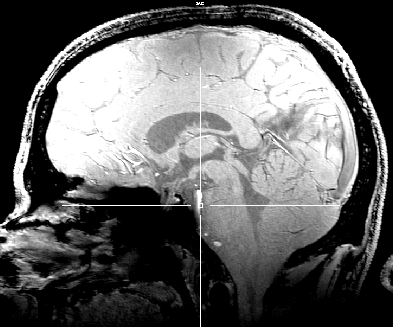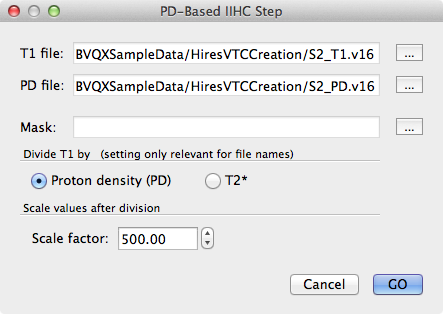BrainVoyager v23.0
Using PD Scans for Inhomogeneity Correction

Spatial intensity inhomogeneities (IIH) can be corrected with the help of the 16 Bit 3D Tools dialog as described in the topic Intensity Inhomogeneity Correction. Before using this tool, however, an extra intensity inhomogeneity correction step can be performed in case that a proton density (PD) measurement is available from the same scanning session with the same slice positioning. A PD scan (see snapshot above) acts as a coarse estimation of spatial intensity inhomogeneities allowing to remove them from the corresponding T1 data set by dividing the T1 data set by the PD data set (ref to Van de Moortele).

The snapshot above shows the PD-Based IIHC Step dialog after selecting the created T1 and PD 16 bit data sets (see .v16 extension). Optionally a mask can be provided (restricting the operation roughly to brain voxels avoiding large division values) but this is not strictly necessary since the subsequent IIHC correction step includes calculation of a brain mask. After running the division step, inhomogeneity within the brain is substantially improved (see snapshot below); voxels outside the brain can be ignored since they will be masked out in the next step. The resulting data sets are stored under the name "S2_T1_DivPD.vmr/.v16" to disk.

In order to further improve the homogenity of the VMR data set, the automatic IIHC procedure can be started by clicking the GO button in the Intensity Inhomogeneity Correction (IIHC) field of the 16 Bit 3D Tools dialog. The resulting 0.3 mm VMR data set "S2_T1_divPD_IIHC.vmr" is shown in the snapshot below.

The data now exhibits no strong intensity inhomogeneities (except the cerebellum) as is evident from the slice images and the clear separation of the white matter and grey matter peak in the global intensity histogram (see snapshot above). In summary, the successive application of PD-based intensity inhomogeneity correction and standard correction successfully removes even strong spatial inhomogeneities as is observed for anatomical data at ultra-high magnetic fields. There are also new MR pulse sequences (e.g. MPRAGE2) that acquire and perform the PD-based inhomogeniety correction on the UHF scanner. If this is the case, the PD-based tool described here need not be applied separately.
Copyright © 2023 Rainer Goebel. All rights reserved.